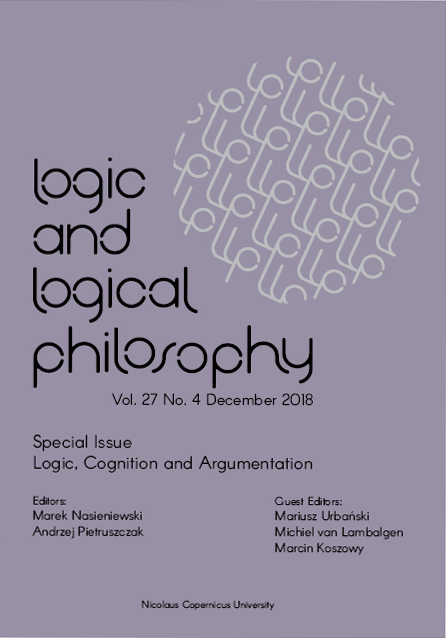What is Diagrammatic Reasoning in Mathematics?
DOI:
https://doi.org/10.12775/LLP.2018.001Słowa kluczowe
diagrammatic reasoning, philosophy of mathematicsAbstrakt
In recent years, epistemological issues connected with the use of diagrams and visualization in mathematics have been a subject of increasing interest. In particular, it is open to dispute what role diagrams play in justifying mathematical statements. One of the issues that may appear in this context is: what is the character of reasoning that relies in some way on a diagram or visualization and in what way is it distinct from other types of reasoning in mathematics? In this paper it is proposed to distinguish between several ways of using visualization or diagrams in mathematics, each of which could be connected with a different concept of diagrammatic/visual reasoning. Main differences between those types of reasoning are also hinted at. A distinction between visual (diagrammatic) reasoning and visual (diagrammatic) thinking is also considered.
Bibliografia
Bakker, A., 2007, “Diagrammatic reasoning and hypostatic abstraction in statistics education”, Semiotica 164: 9–29. DOI: 10.1515/SEM.2007.017
Barwise, J., and J. Etchemendy, 1996, “An enhanced argument for innate elementary geometric knowledge and its philosophical implications”, pages 185–206 in J. Barwise and G. Allwein (eds.), Logical Reasoning with Diagrams, Oxford University Press, New York.
Borwein, P., and L. Jörgenson, 2001, “Visible structures in number theory”, The American Mathematical Monthly, 108, 10: 897–910. DOI: 10.2307/2695413
De Cruz, M., 2007, “An enhanced argument for innate elementary geometric knowledge and its philosophical implications”, pages 185–206 in B. van Kerkhove (ed.), New Perspectives on Mathematical Practices, World Scientific, New Jersey, London, Singapore. DOI: 10.1142/9789812812230_0009
Giaquinto, M., 2007, Visual Thinking in Mathematics, Oxford University Press, Oxford, New York. DOI: 10.1093/acprof:oso/9780199285945.001.0001
Hammer, E., 1994, “Reasoning with sentences and diagrams”, Notre Dame Journal of Formal Logic 35, 1: 73–87. DOI: 10.1305/ndjfl/1040609295
Hanna, G., and N. Sidoli, 2009, “Visualisation and proof: A brief survey of philosophical perspectives”, ZDM Mathematical Education 39, 1–2 (2007): 73–78. DOI: 10.1007/s11858-006-0005-0
Kulpa, Z., 2009, “Main problems of diagrammatic reasoning. Part I: The generalization problem”, Foundations of Science 14: 75–96.
Normann, J., 2003, “Visual reasoning in Euclid’s geometry”, University College London: PhD Dissertation.
Rivera, F.D., 2011, Toward a Visually-Oriented School Mathematics Curriculum, Springer Science+Business Media, Cambridge. DOI: 10.1007/978-94-007-0014-7
Shimojima, A., 2015, Semantic Properties of Diagrams and Their Cognitive Potentials, CSLI Publications, Stanford.
Shin, S-J., 2002, The Iconic Logic of Peirce’a Graphs, MIT Press, Hong Kong.
Pobrania
Opublikowane
Jak cytować
Numer
Dział
Statystyki
Liczba wyświetleń i pobrań: 1685
Liczba cytowań: 0







